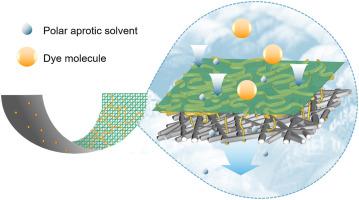Journal of Membrane Science ( IF 8.4 ) Pub Date : 2022-12-15 , DOI: 10.1016/j.memsci.2022.121294 Xinzhu Zhang , Tingyu Li , Zhi Wang , Jixiao Wang , Song Zhao

|
The practical application of solvent-resistant nanofiltration (SRNF) still faces major challenges arising from the swelling and dissolution of substrates in organic solvents, especially in polar aprotic solvents such as dimethylformamide (DMF). To address these issues, polytetrafluoroethylene (PTFE) substrates with strong resistance to organic solvents was employed to fabricate solvent-resistant nanofiltration composite membranes. A novel reverse flexible-chain binding interfacial polymerization (rFB-IP) was proposed to fabricate polyamide (PA) selective layer onto PTFE substrate with ultra-low surface energy. Specifically, aiming at strengthening the bonding force between the substrate and selective layer, PDMS was employed as a flexible-chain binder to generate a cross-linked network on the substrate surface and within the pores to generate an interpenetrating structure with PA selective layer. The as-prepared rPA-PDMS/mPTFE composite membrane exhibited DMF permeance of 0.4 L m−2 h−1 bar−1, 97.1% rejection to Rose Bengal (RB), a stable performance during a filtration process for 120 h, or after being immersed in DMF for 120 d. Therefore, the rFB-IP technique successfully settled the issues of the application of PTFE substrate for composite membrane fabrication, and would have outstanding potential in the development of polar aprotic SRNF membrane.
中文翻译:

通过柔性链结合界面聚合在 PTFE 基底上生成的极性非质子耐溶剂纳滤膜
耐溶剂纳滤 (SRNF) 的实际应用仍然面临着底物在有机溶剂中的溶胀和溶解所带来的重大挑战,尤其是在二甲基甲酰胺 (DMF) 等极性非质子溶剂中。为了解决这些问题,采用耐有机溶剂的聚四氟乙烯(PTFE)基材来制造耐溶剂纳滤复合膜。提出了一种新型反向柔性链结合界面聚合 (rFB-IP),以在具有超低表面能的 PTFE 基材上制造聚酰胺 (PA) 选择层。具体地,为了加强衬底与选择层之间的结合力,PDMS 被用作柔性链粘合剂,在基材表面和孔内生成交联网络,从而生成具有 PA 选择层的互穿结构。所制备的 rPA-PDMS/mPTFE 复合膜的 DMF 渗透率为 0.4 L·m-2 h -1 bar -1,对玫瑰红(RB)的截留率为97.1%,在过滤过程中120小时或在DMF中浸泡120天后性能稳定。因此,rFB-IP 技术成功解决了 PTFE 基底在复合膜制备中的应用问题,在极性非质子 SRNF 膜的开发中具有突出的潜力。

















































 京公网安备 11010802027423号
京公网安备 11010802027423号